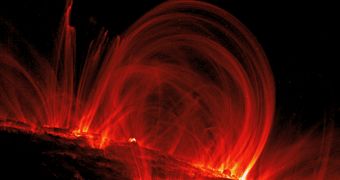The next solar cycle will peak in 2012 and is thought to influence the warming climate of Earth. Scientists are expecting to resolve the predictions by using the NASA satellite designed, built and now operated by the University of Colorado at Boulder. The brightening of the Sun as it approaches the next solar cycle maximum will have regional climatic impact. The next cycle is expected to start in 2008 and the forecasts predict the sun will increase its activity by up to 40 percent than usual.
The mission launched in 2003 to study how the Sun's activity influences the Earth's atmosphere and clime is part of the 88 million dollars program, called the Solar Radiation and Clime Experiment or SORCE conducted by NASA, which decided to extend the program through 2012, in August this year, providing another 18 million dollars of funding for the LASP, which controls SORCE from the campus, by updating commands three times a day to the Space Technology Building in the CU Research Park.
The Solar cycles usually peak at an average of eleven yeas and are thought to be driven by the magnetic lines intersecting its surface, which produce large numbers of sunspots, regions of the surface where gas is cooler than the average temperature of the Sun and modulate brightness from the X-ray to the infrared of the electromagnetic spectrum. The solar cycle, through which the Sun is now passing, peaked in 2002.
This alters the interaction between the surface and the atmosphere of the Earth, which drives global air current circulation. Though the effects of the solar cycles are weak in comparison with some natural effects, like volcano eruption or human emissions of greenhouse gases, it can produce drastic regional temperature changes that could vary by a factor of eight. The last solar maximum produced a global temperature increase by 0.2 degrees Fahrenheit, but the central part of the United States for example experienced a raise in temperature by about 0.7 degrees Fahrenheit, while parts of the coast of California cooled slightly. So it is very important to chart the solar irradiance, since even small changes in the solar output can affect the Earth.
The stratosphere can also heat up, from the increased ultra-violet radiation and could change the atmospheric circulation patterns over the planet, also affecting the clime. The impact over the Earth's clime due to human emissions could never be fully understood without the study of the effect of the solar cycles. During the increased solar activity, the Sun also ejects high quantities of plasma in the form of flares and coronal mass ejection that affect the upper atmosphere by bombarding it with high amounts of deadly particles, which can also disrupt communications and electric power lines.
Of the annual SORCE budget, about one third of that is spent by operating it, one third to produce public data and the rest for the data analysis process.

 14 DAY TRIAL //
14 DAY TRIAL //